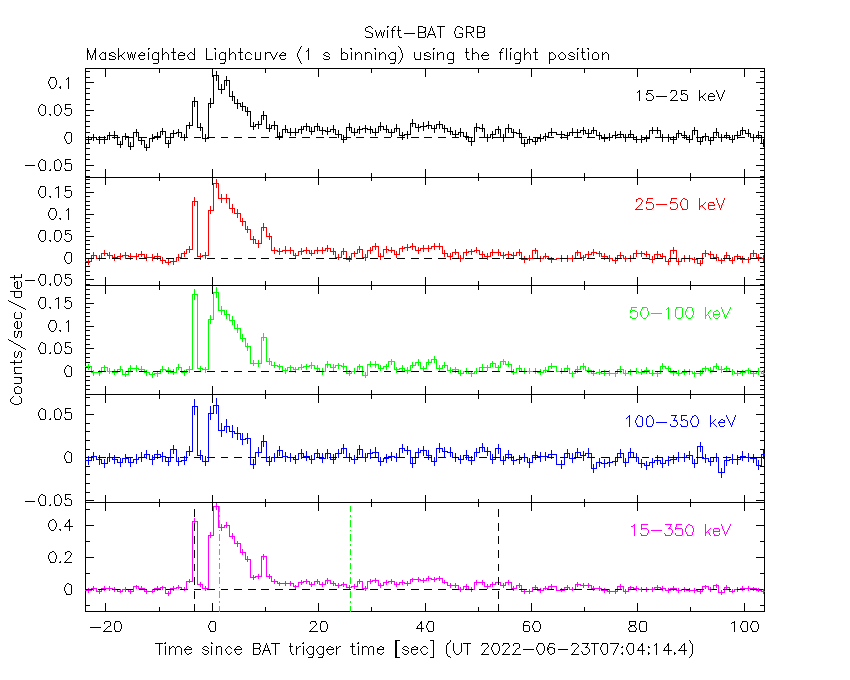
B. Sbarufatti (PSU), V. D'Elia (SSDC and INAF-OAR) and A. Belles (PSU) for the Swift team
At 07:04:14 UT, the Swift Burst Alert Telescope (BAT) triggered and located GRB 220623A (trigger=1111672) (Sbarufatti et al. GCN Circ. 32243). Swift did not slew immediately to the burst. At the time of the trigger, the initial BAT position was 59° from the Sun (3.6 hours East) and 89° from the 29%-illuminated Moon. Table 1 contains the best reported positions from Swift, and the latest XRT position can be viewed at http://www.swift.ac.uk/xrt_positions.
Table 2 is a summary of GCN Circulars about this GRB from observatories other than Swift.
Standard analysis products for this burst are available at https://gcn.gsfc.nasa.gov/swift_gnd_ana.html.
As reported by Barthelmy et al. (GCN Circ. 32264),
the BAT ground-calculated position is RA, Dec = 145.459, 75.823 deg which is RA(J2000) = 0
The BAT light curve (Figure 1) showed a triple-peaked structure.
One possible precursor peak occurred prior to the trigger, another occurred at the trigger time, and the final occurred 10 s post trigger.
At ~40 s there may be broad emission as well.
The time-averaged spectrum from -3.84 to 73.652 s is best fit by a simple power-law model.
The power law index of the time-averaged spectrum is 1.33 ± 0.07.
The fluence in the 15-150 keV band is 3.5 ± 0.1 x 1
The results of the batgrbproduct analysis are available at https://gcn.gsfc.nasa.gov/notices_s/1111672/BA/.
Analysis of the initial XRT data was reported by D'Elia et al. (GCN Circ. 32254). We have analysed 10 ks of XRT data for GRB 220623A, from 4.0 ks to 68.4 ks after the BAT trigger. The data are entirely in Photon Counting (PC) mode. The enhanced XRT position for this burst was given by Beardmore et al. (GCN Circ. 32248).
The light curve (Figure 2) can be modelled with a power-law decay with a decay index of α=1.81 (+0.13, -0.12).
A spectrum formed from the PC mode data can be fitted with an absorbed power-law with a photon spectral index of 1.92 (+0.19, -0.18). The best-fitting absorption column is 2.0 (+0.7, -0.6) x 1
A summary of the PC-mode spectrum is thus:
Total column: 2.0 (+0.7, -0.6) x 1
Galactic foreground: 2.5 x 1
Excess significance: 4.7 σ
Photon index: 1.92 (+0.19, -0.18)
The results of the XRT team automatic analysis are available at http://www.swift.ac.uk/xrt_products/01111672.
The Swift/UVOT began settled observations of the field of GRB 220623A 4034 s after the BAT trigger
(Belles and Sbarufatti GCN Circ. 32252).
No optical afterglow consistent with the XRT position (Kennea et al. GCN Circ. 32244) is detected in the initial UVOT exposures.
Table 3 gives preliminary
magnitudes using the UVOT photometric system
(Breeveld et al. 2011, AIP Conf. Proc., 1358, 373).
No correction has been made for the expected extinction in the Milky Way
corresponding to a reddening of

Figure 1. The BAT
mask-weighted light curve in the four individual and total
energy bands. The units are counts

Figure 2. The XRT light curve.
Any data from a crosshatched region are not included in the fit.
| RA (J2000) | Dec (J2000) | Error | Note | Reference |
|---|---|---|---|---|
| 0 |
+75°49'15.6" | 2.0" | XRT-final | UKSSDC |
| 0 |
+75°49'15.6" | 2.1" | XRT-enhanced | Beardmore et al. GCN Circ. 32248 |
| 0 |
+75°49'22.9" | 1.0' | BAT-refined | Barthelmy et al. GCN Circ. 32264 |
| Band | Authors | GCN Circ. | Subject | Observatory | Notes |
|---|---|---|---|---|---|
| Optical | 32245 | iTelescope optical upper limit | iTelescope | upper limits | |
| Optical | Hu et al. | 32251 | BOOTES-5/JGT optical afterglow detection | BOOTES | detection |
| Optical | Malesani et al. | 32253 | NOT optical observations | NOT | |
| Optical | Pankov et al. | 32255 | AbAO optical upper limit | Abastumani Astro. Obs. | upper limits |
| Optical | Schneider et al. | 32271 | T193-OHP optical upper limit | upper limits | |
| Optical | Swain et al. | 32273 | GIT optical upper limits. | GROWTH-India Tel. | upper limits |
| Gamma-ray | Gopalakrishnan et al. | 32246 | AstroSat CZTI detection | CZTI | |
| Gamma-ray | Ursi et al. | 32247 | AGILE detection | AGILE | |
| Gamma-ray | Frederiks et al. | 32258 | Konus-Wind detection | Konus-Wind |
| Filter | Exp(s) | Mag | ||
|---|---|---|---|---|
| whit |
4034 | 4184 | 147 | >19.9 |
| white | 4034 | 5415 | 344 | >20.1 |
| v | 4190 | 9642 | 326 | >18.9 |
| b | 5010 | 5210 | 197 | >19.4 |
| u | 4805 | 5005 | 197 | >19.0 |
| w1 | 4600 | 4800 | 197 | >19.3 |
| m2 | 4395 | 4595 | 197 | >19.9 |
| w2 | 5421 | 5621 | 197 | >19.6 |
Table 3. UVOT observations reported by Belles and Sbarufatti (GCN Circ. 32252). The start and stop times of the exposures are given in seconds since the BAT trigger. The preliminary 3-σ upper limits are given. No correction has been made for extinction in the Milky Way.
June 28, 2022